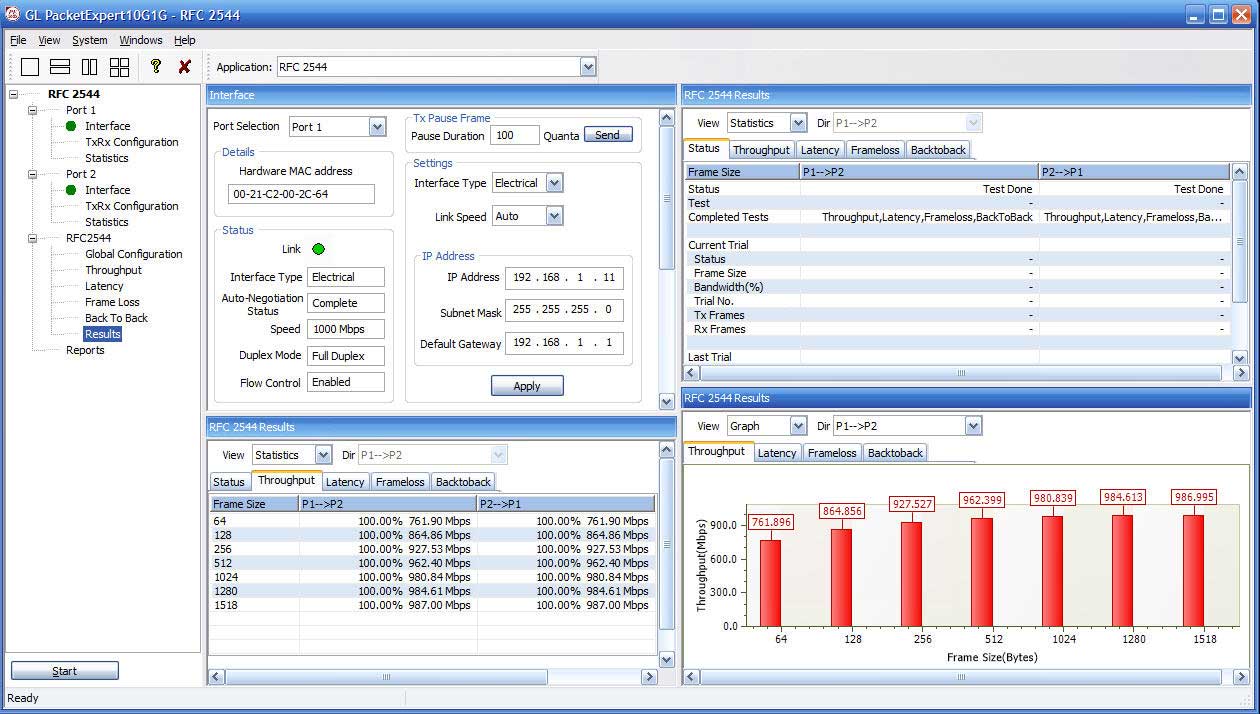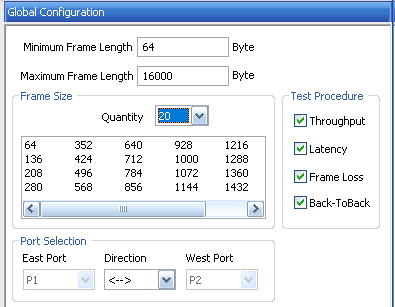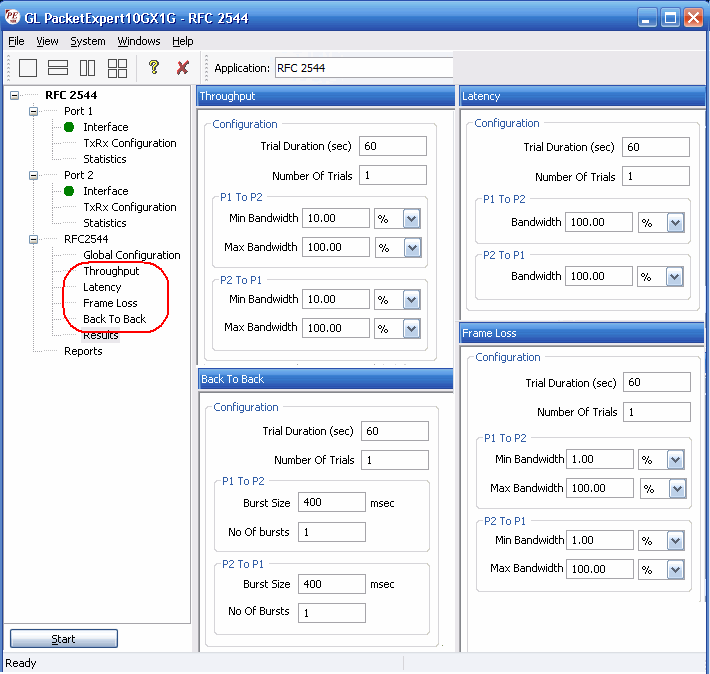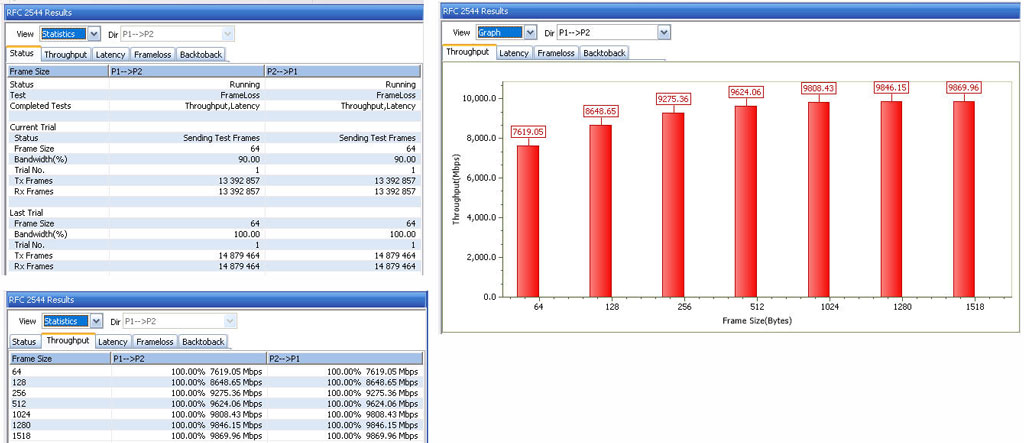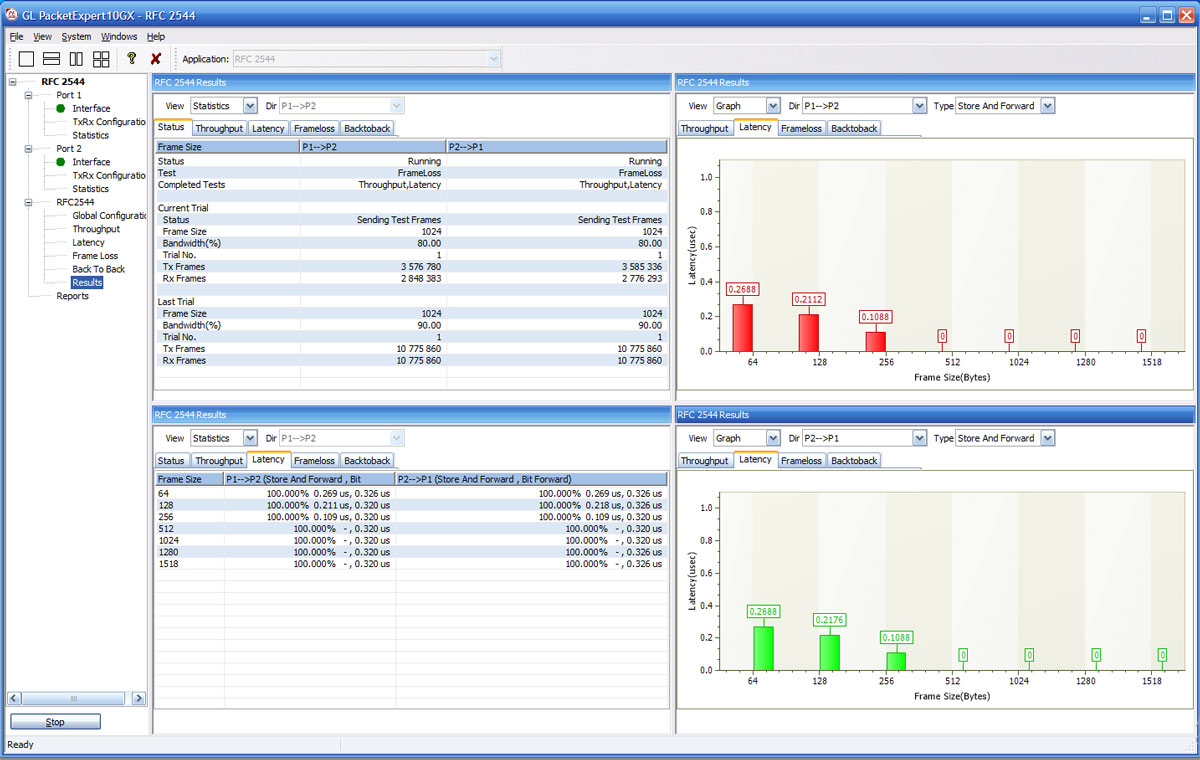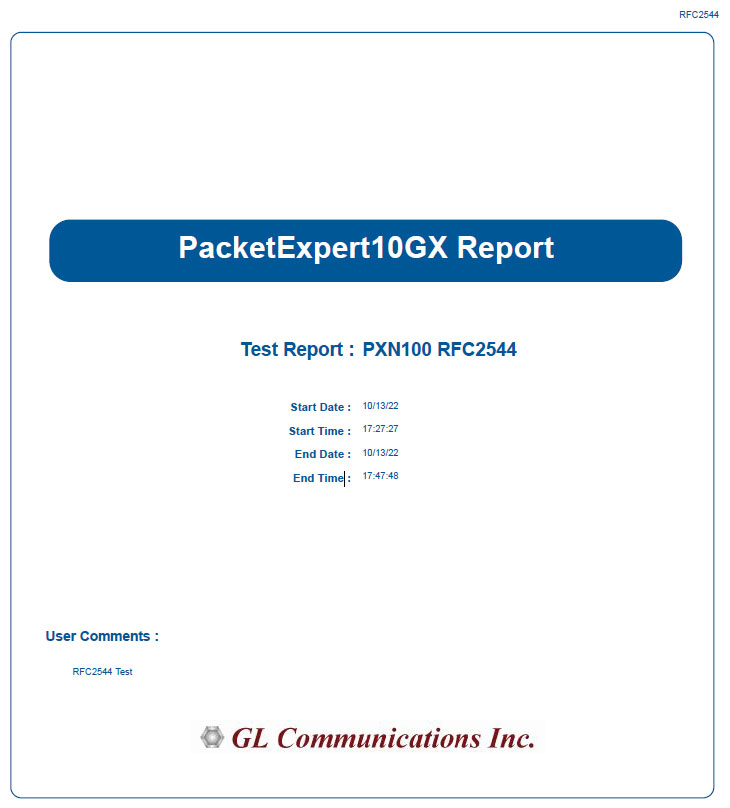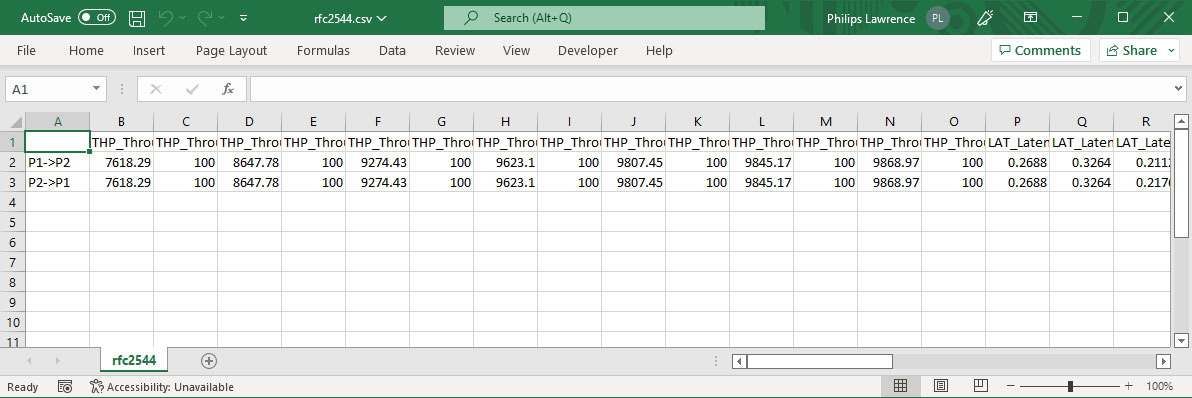RFC 2544 Network Testing
RFC 2544 Tests - Ethernet Throughput, Latency, Frame Loss, and Back-to-Back performance tests.
Request a Demo / Quote Brochuresample Report - 1G sample Report - 10G
Overview
PacketExpert™ supports Throughput, Latency, Frame Loss and Back to Back tests as specified in RFC 2544. RFC 2544 defines a specific set of tests that can be used to evaluate equipment performance. It defines a set of 4 tests - Throughput, Latency, Frame Loss Rate, and Back-to-back frames. Networks referred in RFC 2544 can be Local Area Networks (LAN) or Wide Area Networks (WAN). RFC 2544 gives testing details for different kinds of LANs Ethernet, 16 MB Token Ring, FDDI.
RFC 2544 network testing includes the following types of measurements:
- Throughput - Maximum number of frames per second that can be transmitted without any error
- Latency - Measures the time required for a frame to travel from the originating device through the network to the destination device.
- Frame Loss - Measures the network’s response in overload conditions
- Back-to-Back - It measures the maximum number of frames received at full line rate before a frame is lost.
In Dual port RFC 2544 test, PacketExpert™ allows Ethernet Throughput, Latency, Frame Loss, and Back-to-Back performance tests in accordance with RFC 2544 specifications on 10G/2.5G/1G ports. The test is setup such that the traffic can be generated and transmitted on either of the dual ports and the looped back traffic from the DUT is received on the opposite port validating the test parameters.
In Single port RFC 2544 test, the PacketExpert™ allows Ethernet Throughput, Latency, Frame Loss, and Back-to-Back performance tests in accordance with RFC 2544 specifications on 10G/2.5G/1G ports. The test is setup such that the traffic is transmitted on 10G/2.5G/1G ports and the PacketExpert at the DUT end can be configured to loop the traffic back on the same port measuring the Tx and Rx time thus calculating the latency
In single port RFC 2544 test,
- For PacketExpert™ 1G, the RFC 2544 test can be done either on Port #2 or Port #3 at a time and it is not possible to run RFC 2544 test on both the ports (Port #2, Port #3) simultaneously.
- For PacketExpert™ 10G or 10GX, the RFC 2544 test can be done either on Port #1 or Port #2 at a time and it is not possible to run RFC 2544 test on both the ports (Port #1, Port #2) simultaneously.

Single Port RFC 2544
The test tool supports multiple functionalities -
- Wire speed BERT
- Smart Loopback
- RFC 2544 Testing (Throughput, Latency, Frame Loss, and Back-to-Back Tests)
- PacketBroker (Packet capture, filtering, aggregation, and modification)
- Wirespeed Ethernet Packet Capture and Playback
- ExpertSAM™ (ITU-T Y.1564)
- Multi-Stream UDP/TCP Traffic Generator and Analyzer
- ExpertTCP™ (TCP Throughput Testing - RFC 6349)
Features
- Throughput, back-to-back, latency and frame loss testing supporting uni-directional and bi-directional traffic between ports
- Supports RFC 2544 testing on Electrical/Optical ports (1000 Mbps) and Electrical/Optical ports (10G/2.5G/1G)
- Support for frame lengths from 64 bytes to Jumbo frames (up to 16000 bytes)
- Includes various parameter configurations such as Test Selection, Frame Sizes selection, Unidirectional/Bidirectional, Number of trials, Trial Duration, and many more.
- User-defined options to configure various packet header parameters, like MAC addresses, IP addresses, UDP ports, VLAN ID, MPLS Labels, and more.
- Results are displayed in both tabular as well as graphical format.
- Console based CLI (C# and Python client) with additional CXE100 licenses provides the capability of remote operation, and automation
RFC 2544 Test Configurations
PacketExpert™ supports Throughput, Latency, Frame Loss and Back-to-Back tests as specified in RFC 2544. RFC 2544 can be done over Framed Ethernet (Layer2), Stacked VLAN (Q-in-Q), Stacked MPLS, IP or UDP.
RFC 2544 allows the test frame to be configured with Stacked VLAN and Stacked MPLS. This way, end to end RFC 2544 test can be conducted across a Carrier Ethernet/MPLS network.
Global configuration option includes parameter settings that are common to all the 4 tests - Throughput, Latency, Back-to-Back, Frame Loss. This application supports frame lengths from 64 bytes to Jumbo frames (up to 16000 bytes). Due to addition of stacked VLAN and stacked MPLS, the minimum length required for frame can come up to be > 64, anything lesser, traffic may not be sent at all. So, this display is provided to help user to configure the correct frame length. It includes an option to configure with the minimum frame length required. Also, any Frame Size configured less than the minimum frame length will be rejected. RFC 2544 recommends 20 different frame sizes for Ethernet.
Each RFC 2544 test configuration includes various parameter such as Test Selection, Frame Sizes, Unidirectional/Bidirectional, Number of trials, Trial Duration, and many more. It also provides user-defined options to configure various packet header parameters, like MAC addresses, IP addresses, UDP ports, VLAN ID, MPLS Labels, and others.
RFC 2544 Test Results
Results are displayed in both tabular as well as graph format.
- Status - displays test status such as In Progress, Completed, and Aborted. In addition, it displays status of learning frames and test frames for the current trial along with Bandwidth, Frame Size, and Frame Count.
- Throughput - Throughput results are displayed in terms of bandwidth (both in percentage as well as Mbps) for each frame size. Graphically, it is plotted as throughput vs frame size.
- Latency - Latency values are displayed in terms of microseconds for each frame size. Graphically, the latency value is plotted against frame size.
- Back-to-Back - Back-to-Back values are displayed in terms of the burst size (in milliseconds) for each frame size. Graphically, the burst size is plotted against frame size.
- Frame Loss - Frame Loss results are displayed in terms of the throughput (in percentage) measured over the range of input rates (in percentage) for each frame size. Graphically, for each frame size, the throughput is plotted against the test rate. For multiple frame sizes, there will be multiple line graphs.
Report Generation
RFC 2544 application supports reports generation in PDF and CSV file formats detailing the configuration and results of the previously run test.
The PDF report file generated includes all the details such as the Test configuration, Test results, Interface configuration etc. For RFC 2544, results are saved in tabular as well as graphical format, just as in the GUI. The CSV report file generated includes only the Results and the Statistics parameters for the test conducted.
Resources
Note: PCs which include GL hardware/software require Intel or AMD processors for compliance.
Please Note: The 'Pxx' in the Item No. refers to the hardware platform on which the software will be running. Therefore, 'Pxx' can either be PXE (1G) or PXG (10G) or PXN (10GX) depending upon the hardware.
| Item | Description |
|---|---|
| PXN100 | PacketExpert™ 10GX |
| PXN101 | 10G option for PXN100 |
| PXE100 | PacketExpert™ 1G |
| CXN100 | CLI Server for PXN100 |
| CXE100 | CLI Server for PXE100 |
| PacketExpert™ 10GX - Brochures |
|---|
| PacketExpert™ 10GX |
| PacketExpert™ 10GX - RFC 2544 |
| PacketExpert™ 10GX mTOP™ |
| PacketExpert™ 10GX CLI |
| PacketExpert™ 1G - Brochures |
| PacketExpert™ 1G |
| PacketExpert™ 1G - RFC 2544 |
| PacketExpert™ 1G - mTOP™ |
| PacketExpert™ 10GX - Presentations |
| PacketExpert™ 10GX |
| PacketExpert™ 1G - Presentations |
| PacketExpert™ 1G |
| PacketExpert™ 10GX - Sample Reports - PDF |
| PacketExpert™ 10GX - 1G-Ports RFC 2544 Report |
| PacketExpert™ 10GX - 10G-Ports RFC 2544 Report |
Webinar
Comprehensive Ethernet Testing Solutions

